Use the Right Tools for Detecting Plant Pathogens
To find a missing object in a crowded garage, all you need is a good flashlight. But let’s say you want to look into outer space and view faraway nebulae and galaxies that are so unthinkably distant that their faintness makes them invisible to us.
You would design and build, say, a huge space telescope with a light-collecting mirror measuring 21 feet across. Then you would launch your telescope into solar orbit. This tool would be the largest ever optical telescope in space, would take amazing photographs, and of course would be named the James Webb Space Telescope, which NASA deployed in December 2021.
Depending on what you want to detect, you need the right tool. The same goes when attempting to detect a plant pathogen.
Microscopy
In the struggle against plant diseases, it is essential to detect the organisms that cause such losses.

Microscopes allow diagnosticians to view the structures made by plant pathogenic fungi, such as this oospore produced by a Pythium species.
Photo by Steven T. Koike
Years of research have resulted in a number of tools that plant pathologists and agriculturalists use. Microscopes, of course, are one of the most familiar tools. Low-power dissecting microscopes, high-power compound light microscopes, and ultra-high-resolution electron microscopes all provide the ability to actually see the pathogenic organism. Once detected, the diagnostician may be able to identify the farmer’s problem.
Culturing Lab
Another detection tool is the micro-biology culturing lab. Personnel will use microbiological methods to extract, purify, and grow pathogens on sterile agar media poured into petri plates. This culturing protocol requires washing and sanitizing the plant sample, surgically cutting open the plant, excising specific sections of the infected tissue, and placing the extracted pieces into the appropriate agar medium.
Many different agar media are available depending on the targeted pathogen. There are specialized agar media recipes designed to recover fungi such as Pythium, Phytophthora, Fusarium, Verticillium, or Thielaviopsis. And other recipes for bacteria like Agrobacterium, Pseudomonas, or Xanthomonas.
After completing these culturing procedures, the isolation petri plates are incubated. If successful, the pathogen residing in the tissue grows out into the agar, allowing it to be detected via microscope examination.
Immunological Tools
The ELISA (enzyme-linked immunosorbent assay) technique uses antibodies to search out and identify proteins produced by pathogens. Following a detailed procedure, mashed up extracts from diseased plants are exposed to antibodies that can recognize specific pathogen proteins.

Serological techniques, in which antibodies are mixed with plant extracts, can help identify many plant pathogens.
Photo by Steven T. Koike
If we suspect a lettuce plant is infected with cucumber mosaic virus, we’ll deploy CMV antibodies. If a tomato plant might have tomato spotted wilt virus, we use antibodies from that virus. A suspect angular leaf spot case of strawberry will call for Xanthomonas fragariae antibodies. Positive reactions will signal affirmative detection of the targeted organism.
Molecular Methods
DNA- or RNA-based molecular methods are powerful detection tools that are part of the plant disease diagnostic arsenal.
Researchers characterize key genes and molecular fragments, called markers, of a pathogen’s genome. Having identified markers that are unique to a pathogen, detection tools called primers can be deployed to search for this molecular signature.
Basically, you ground up and process plant tissue to release the pathogen’s DNA/RNA. With the DNA/RNA isolated and purified, you mix this extract with the appropriate primers.
If the pathogen is present, the primers recognize the molecular marker, attach to these pieces of DNA, and register a positive reaction in the molecular test.
There are many of these molecular testing techniques based on this primer-marker system. The polymerase-chain reaction (PCR) is commonly used in plant disease diagnostics. But there are other related tools, such as RPA (recombinase polymerase amplification).
All tools have their limitations. Plant pathogen detection tools certainly have their limits as well. The usefulness and accuracy of different diagnostic tools will vary depending on the pathogen type, nature, and quality of the plant sample and objective of the analysis.
Combining the tools, using them as appropriate, and remaining cognizant of their limitations, will result in the best possible integrated approach to disease diagnostics.










